Choice opponents have been known to throw contradictory arguments out against private choice programs. One moment they will claim that the majority of kids using universal choice programs were already going to private schools. A few moments later they will claim such programs are draining district schools of students and money. The irony of these mutually exclusive claims will often escape the person making them, and you can see hints of both in this New York Times podcast titled Why So Many Parents are Opting Out of Public Schools.
Sigh
Choice opponents make all kinds of claims, but not many can withstand even a modicum of scrutiny. Let’s take for instance a widely repeated fable- that Arizona’s universal ESA program has “busted” the state budget.
If you actually examine state reports like this one for district and charter funding and also this one for ESA funding, you wind up with:
Arizona districts have exclusive access to local funding among other things and are by far the most generously funded K-12 system in the state. Districts, charters and ESAs all use the state’s weighted student funding formula, and ESAs get the lowest average funding despite having a higher percentage of students with disabilities participating than either the district or charter sector.
If you track the percentage of students served by the district, charter and ESA sectors respectively, and the funding used by each as a percentage of the total, you get:
So, there you have it; supposedly the sector educating 6% of Arizona students for 4% of the total K-12 funding is “bankrupting” the state of Arizona. Meanwhile the system, which generated an average of $321,700 for a classroom of 20 ($16,085*20), is “underfunded.”
A group of 20 ESA students receiving the average scholarship amount receive $123,780 less funding, but they are (somehow) “busting the budget.” The fact that a growing number of Arizona students opt for a below $10k ESA rather than an above $16k district education tells us something about how poorly districts utilize their resources. So does the NAEP.
There is a school sector weighing heavily upon Arizona taxpayers, but it is not the ESA program.
**SPOILER ALERT! DO NOT READ IF YOU ARE UNDER THE AGE OF 8**
Western cultures, for some strange reason, involve rituals where we pretend that various “fairy creatures” exist, particularly with children: the Tooth Fairy, a jolly old elf with flying reindeer who brought me an awesome Big Wheel in 1973, egg and goody hiding rabbits, etc. When I became a parent, I played along with these rituals, but then at some point questioned why I was doing it. On the one hand, I didn’t want my children to be those killjoy types who went around bursting the bubbles of other kids. On the other hand, I did not want to train my children not to trust me. I decided to allow the “fun” to go on until they each reached a certain age, then to explain to them that these things are traditions and that it would be best to allow their friends to figure it out on their own.
So, dear reader, I assume that you have reached a certain age and that you are prepared to know the truth about the last fairy creature. Belief in this one tends to persist much longer than the others and is alas, more detrimental. Sorry to be a killjoy, but here goes:
Philosopher kings are not real.
This was my main thought upon reading Mike McShane’s recent entry in a debate about school choice regulation. Go read it. I’ll wait here.
Go on…
Okay, good. My favorite part involved the Gilded Age meat baron, but McShane made several crucial points. Local school boards, state governments and the federal government all regulate public schools in a very active fashion. I could produce multiple graphs from NAEP, PISA, etc., showing what a pig’s breakfast American academic achievement has become, but you have already seen them, so I will spare you. Why are American schools so wretched despite so much regulation? Oh well, that is simple: regulation is not made by philosopher-kings but rather by politics. Politics has an amazingly consistent record of fouling things up.
The philosopher-king fairies, invented by Plato, are a specially trained and educated aesthetic elite who, disinterested in fame or wealth, love only wisdom and justice. Having thus earned the right to rule over us lesser mortals, we proles should feel deferential and deeply grateful for their sacrifice. Again, sorry to burst your bubble, but these people do not exist in the real world. Out here in the real world, mere humans with all kinds of motivations (political and otherwise), limits to their knowledge, greed, stupidity and other normal human failings create regulations. Those of us fortunate enough to live in a democracy get the chance to throw the bums out when we’ve had enough. Just in case you haven’t noticed, a major subtext of politics these days involves bums that voters can’t throw out.
Politics, not philosopher-kings, runs regulation, and politics runs on self-interest far more than on benevolent technocratic wisdom. Choice programs must cope with powerful organized interests that yearn to use regulation as a tool to domesticate choice opportunities and find it in their self-interest to do so. The default position of choice supporters should therefore be to view the calls for regulation with a deep skepticism; it is not paranoia when people really are out to get you.
None of this is to say that it is possible to pass choice legislation without regulation; it is not. I am not aware of any program anywhere that operates without some degree of regulation. American parents, however, want a radically different K-12 system than the one government forces them to pay for (see above). The way forward is to allow families to partner with educators to sort through new schools and education methods. Heavily regulated choice systems might get to something close to the K-12 system parents want and deserve before the heat-death of the universe, but then again, they might not.
America’s founders fought a grueling war against the most powerful country in the world based upon what was then a radical idea, that people could live better without royalty to boss them around. The divine right of kings was another myth humanity needed to grow up and discard, and that should include philosopher-kings.
Seppie Furlano gets dirty at school. It happens. He’s 8, he’s a boy, and one day a week, his classroom is a mixture of trees, shrubs, dirt, and mud.
And there’s a creek.
Seppie and his classmates, who include his 10-year-old sister, Luciana, climb trees, discover tadpoles, and build small boats out of twigs and leaves to float down the creek.
Luciana’s mom reports that her daughter doesn’t get quite as dirty as her brother, but she has just as much fun. Together, they explore and learn about the great outdoors and all it has to offer at Curious and Kind, a nature-based, hybrid school located near their Sarasota home.
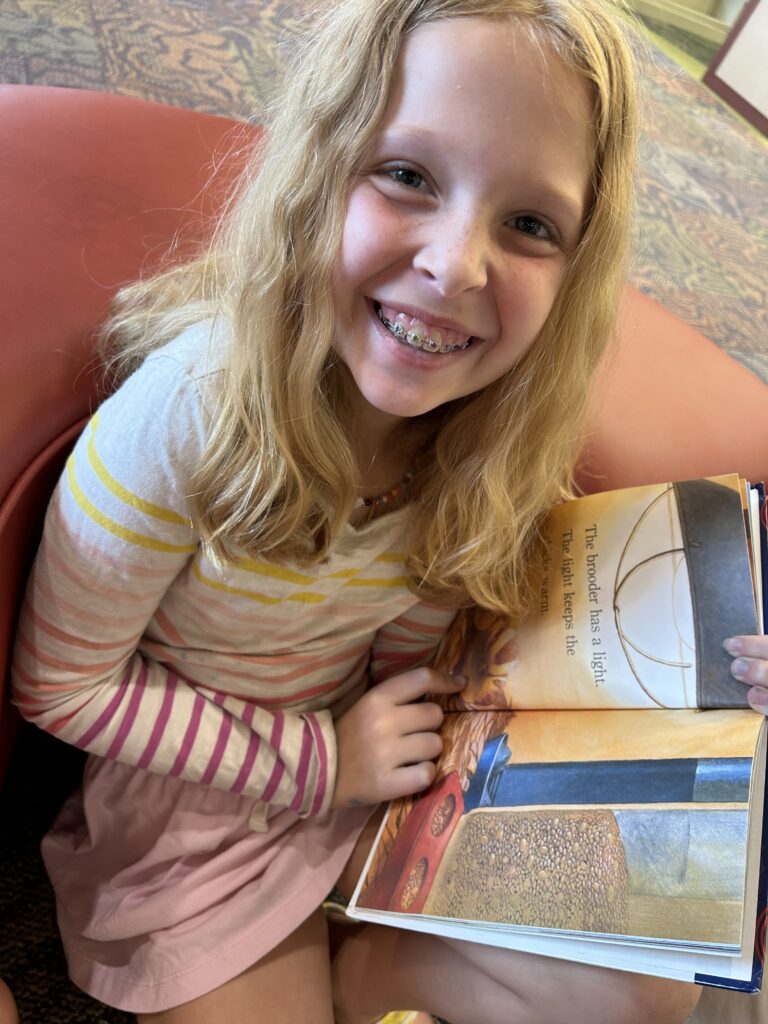
Luciana is dyslexic, but with the help of an online reading tutor available with her ESA, she is now able to read books.
The school, started two years ago by Justine Wilson and her husband, Chris Trammel, is now part of the hybrid learning, homeschool experience that Kristina and Dominic Furlano designed for their children with the help of education choice scholarships managed by Step Up For Students.
“I absolutely love the scholarship,” Kristina said. “The scholarship has made our homeschooling journey what it is today. My kids are absolutely thriving.”
Actually, Kristina balks a little at the word homeschooling, because Luciana and Seppie learn both inside and outside the home.
“I feel like that is the complete opposite of homeschooling,” she said.
The scholarships are education savings accounts (ESA) that allow the Furlano’s flexibility to tailor the homeschool curriculum toward each child’s needs and interests. They have joined the growing number of parents in Florida who are taking the hybrid route, finding educational environments outside the home to give their children something they can’t experience inside the home.
Parents are supplementing in-home learning by sending their children to educational environments that specialize in such activities as music, fashion, cooking, robotics, athletics, and nature. Call it “à la carte learning.”
Curious and Kind offers four different programs for different age groups, from “walking ages” to teenagers. Depending on the program, families can enroll what the school calls their “explorers” one, two, or three days a week. (Read more about the school here.)
“We are part of a homeschool family's menu that they designed specifically for their child,” Justine Wilson said.
Luciana takes sewing and musical theater classes, while Seppie attends a local STEM program that offers classes in Lego robotics. On Tuesdays, the two can be found at a local skate park with other homeschooled children. Some parents use skateboarding as a physical education requirement. Afternoons are often blocked out for reading tutors.
This summer, the two will participate in several camps, more outdoor fun at Curious and Kind, and a baking camp. If all goes well, baking camp will turn into baking classes during the 2025-26 school year. Kristina has already expanded her children’s outdoor learning for next year by enrolling them at Curious and Kind for two days a week.
“I like my kids to be out of the house, but only for a couple of days a week. I don't want them gone five days a week,” Kristina said. “If they are gone two or three times out of the week, it gives them some structure, and they get to make friends, and I get to do what I need to do while they're gone.”
Luciana originally attended a local private school. She is dyslexic, though, and that hindered her learning. She had to repeat the first grade. She also suffered from anxiety at school. So, Kristina and Dominic decided homeschooling was the best option.
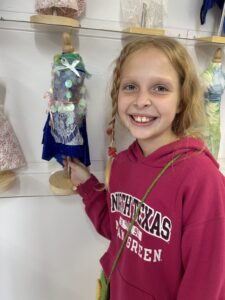 Because she is dyslexic, Luciana qualified for the Family Empowerment Scholarship for Students with Unique Abilities.
Because she is dyslexic, Luciana qualified for the Family Empowerment Scholarship for Students with Unique Abilities.
Because Seppie is homeschooled, he qualified for the Personalized Education Program (PEP) scholarship.
The flexibility of homeschooling allows Kristina to schedule online reading tutors for the afternoon, when she feels Luciana and Seppie are more receptive to video lessons. It works.
“My daughter read her very first book two weeks ago, so that was amazing,” Kristina said. “We were all so worried about this child, and then she read this book. She’s on her sixth book now. I mean, they're all the very beginner books, but she's got it, and she's putting it together, and it's just been really helpful to have the tutor.”
The ESAs pay for homeschool curriculum, reading tutors, a ton of art and sewing supplies, sewing and outdoor classes, musical theater, and summer camps.
Luciana has learned to sew by taking classes from a mother who also homeschools her children.
“Luciana is using a real sewing machine. She designs. She cuts the fabric out, picks her fabric, picks her string, and sews the entire thing,” Kristina said.
Luciana has made pajama pants, a skirt, a hat, bags, and sleeping masks.
“They do fashion shows,” Kristina said. “She has a little portfolio.”
Because of Luciana’s dyslexia, Kristina said a brick-and-mortar school will never be a good fit for her daughter. She has no intention of sending Seppie to one, either.
“The beauty of homeschooling is to not make your child have this cookie-cutter education that society wants your children to have,” Kristina said. “Now we have this generation of home-schooled children who are going to take over the world with their creativity. They're not going to work 9-to-5. They’re going to be entrepreneurs.”
EdChoice has an interesting survey question comparing what sort of school parents would prefer (district, charter, private or home) and comparing the results to actual enrollment patterns. In 2024 it looked like this:
There is a lot happening in that chart, starting with the apparent desire of approximately 50% of the parents of district students to have their students somewhere else. Of course, a great many legal and practical constraints stand between preference and reality, which is why we have an education freedom movement and why we find so much opposition from the insecure K-12 reactionary community. Taking the surveyed demand as a part of a thought experiment around “what would it take to give families what they want?” can be illuminating. Of course, in the real world, these things change only gradually. Arizona has the highest percentage of students in charter schools at 21% or so, but it took three decades to get there for all kinds of reasons, including the need to have school space, which involved a great deal of construction and debt. We live in a world of charter and private school scarcity relative to demand, and keeping up the previous (inadequate) pace of construction may prove difficult.
Using my advanced skills acquired in the Texas public school system between 1972 and 1986, I have used this surveyed demand to calculate an implied demand for an additional 1.1 million charter school spaces. Don’t hold your breath waiting for them. It took almost three and a half decades to reach 3.7 million, and if you’ll now take a look at the first chart above, you’ll see that most of that three-and-a-half-decade period involved relatively low and almost continually declining long term interest rates between 1991 and 2021.
After 2021, both interest and building costs went up for charter school construction. Interest rates of course could go down, but they could also (gulp) go further up. A slowdown in the rate of new charter openings happened before the increase in interest and construction costs:
The little green force mystic taught us “always uncertain the future is,” but it appears to me that circumstances will require the rise of different school models that create seats sans debt. The old expression holds that God doesn’t close a door without opening a window, and the recent rise in interest rates happened almost simultaneously with the rise of pandemic pods and a la carte learning.
 At the annual Florida School Choice Conference and School Choice Summit, attendees got their customary sendoff from Jim Horne, a former state senator, state education commissioner and pioneer of the state’s charter school movement.
At the annual Florida School Choice Conference and School Choice Summit, attendees got their customary sendoff from Jim Horne, a former state senator, state education commissioner and pioneer of the state’s charter school movement.
“We were charged to be laboratories of innovation,” he told the audience of school leaders in his keynote speech. “I challenge you to step out of the proverbial box. If you don’t innovate, you will stagnate.”
So far, charter schools have resisted the forces of stagnation. A report from the National Alliance for Public Charter Schools shows charter schools added 83,000 new students during the 2023-24 school year, as enrollment in other public schools shrank.
This school year, they added thousands more students in Florida. Recent figures from the state Department of Education show statewide charter school enrollment topped 400,000 during the 2024-25 school year.
That growth comes two years after state lawmakers passed House Bill 1, which allowed universal education choice scholarship eligibility and created the Personalized Education Program, a flexible scholarship for parents who fully customize their children’s education.
The legislation unlocked new opportunities for charters to heed Horne’s call to serve as laboratories of innovation by providing a la carte classes and services to scholarship students who did not attend public or private school full time. Need AP chemistry or calculus? No problem.
So far, five charter school organizations have partnered with Step Up For Students to offer individual courses to scholarship families, with more in the works.
“I think it’s a great idea and something that fits right into the charter school realm,” said Karen Seder, director of educational standards at Kid’s Community College, which operates three schools, including one that includes middle school, in Riverview, a southeastern suburb of Tampa.
The schools expect to begin offering courses soon after leaders decide what might work best. Seder said it might be easier to offer electives first and add core academics after seeing how things work out.
Though she sees the ability to help part-time students as a win for everyone, she sees the need to protect charter schools’ uniqueness, which comes from their ability to offer strong organizational cultures and coherent, specialized programs, for example, STEM, music or programs for students with learning differences. However, she called the push to maximize options for as many students as possible “the right mindset” for society.
“Ultimately, when you and I are no longer working and need somebody to take care of us, all these kids are going to be the ones responsible, so it shouldn’t matter to us if they’re homeschool or private school or public school or charter school or wilderness school, she said. “We need to make sure we’re raising kids that have the best education that we can, and our public dollars should be going to all of our kids.”

For we who grew up tall and proud
In the shadow of the mushroom cloud
Convinced our voices can't be heard
We just want to scream it louder and louder and louder
— Queen, Hammer to Fall
Recently we reviewed in these pages' election returns by generation showing that Vice President Kamala Harris won a majority of most generations but decisively lost Gen X, and thus the election as a whole. We Gen Xers shrugged off the daily looming prospect of global thermonuclear annihilation. Latchkey kids had more pressing things to concern themselves with. Worse still, we survived the cultural oppression of the Baby Boomers and their allegedly “classic” rock playing the same seven songs on infinite radio repeat. Punk, funk, new wave, alternative, grunge — please just give us something else to listen to!
But I digress; in addition to our shared childhood experiences, many in Gen X were the parents of school-aged children during the COVID-19 dumpster fire. This made many see red far more than even having to listen to Stairway to Heaven 18,589 times. K-12 traditionalists/reactionaries might hope to wait out the Gen X generation — some of us have become grandparents — we can’t live forever. Delightfully, still greater challenges for the status-quo tribe loom in the immediate future.
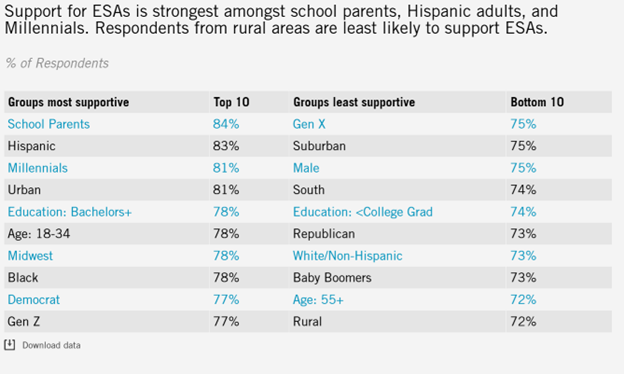
Polls, like the one above from Ed Choice, show that both Millennials and Gen Z show higher support for school choice than either Gen X or Baby Boomers. This is hardly surprising. There were only three channels on television (four if you count PBS) when Gen X was young, and we were thrilled when cable television came along and provided an additional 50 or so channels. Young people these days can stream anything, anytime, anywhere. Future generations will not even understand the phrase “cutting the cord” as they won’t have ever experienced a cord to begin with.
It's hard to imagine public education remaining one-size-fits-all in a world of ubiquitous customization. Democracy can be terribly unforgiving to candidates who attempt to give voters what they think they need rather than what they want. Ultimately this points to a bipartisan future for K-12 choice.
Chuck Todd for instance noted on election night:
Both Florida and Texas have been very aggressive about expanding school choice. Where have Republicans made the greatest gains among Hispanic voters? Florida and Texas. So, education, the economy, those issues, bread and butter issues, and that is how they talk to them. I’m not saying Democrats weren’t, but the cultural issues don’t play as well with Hispanic voters as they may with college-educated whites or even African Americans.
Political parties don’t generally volunteer to play the role of the nail indefinitely; it’s better to be a hammer. Gen Xers are old enough to have seen a bipartisan coalition for choice come, and to have seen it go. Will we see an effort to get a new bipartisan coalition rushing headlong as a new goal, or will we be waiting for the hammer to fall again?
Stay tuned.
PALM BEACH GARDENS, Fla. – Cristina Bedgood, a 15-year former public school teacher, took two years to craft plans for her own private learning center. She knew she needed 40 students in year one to make it work. But in April, when she held her first open house for Curious Innovators of America, she looked out the front door five minutes before the start time and saw … nobody.
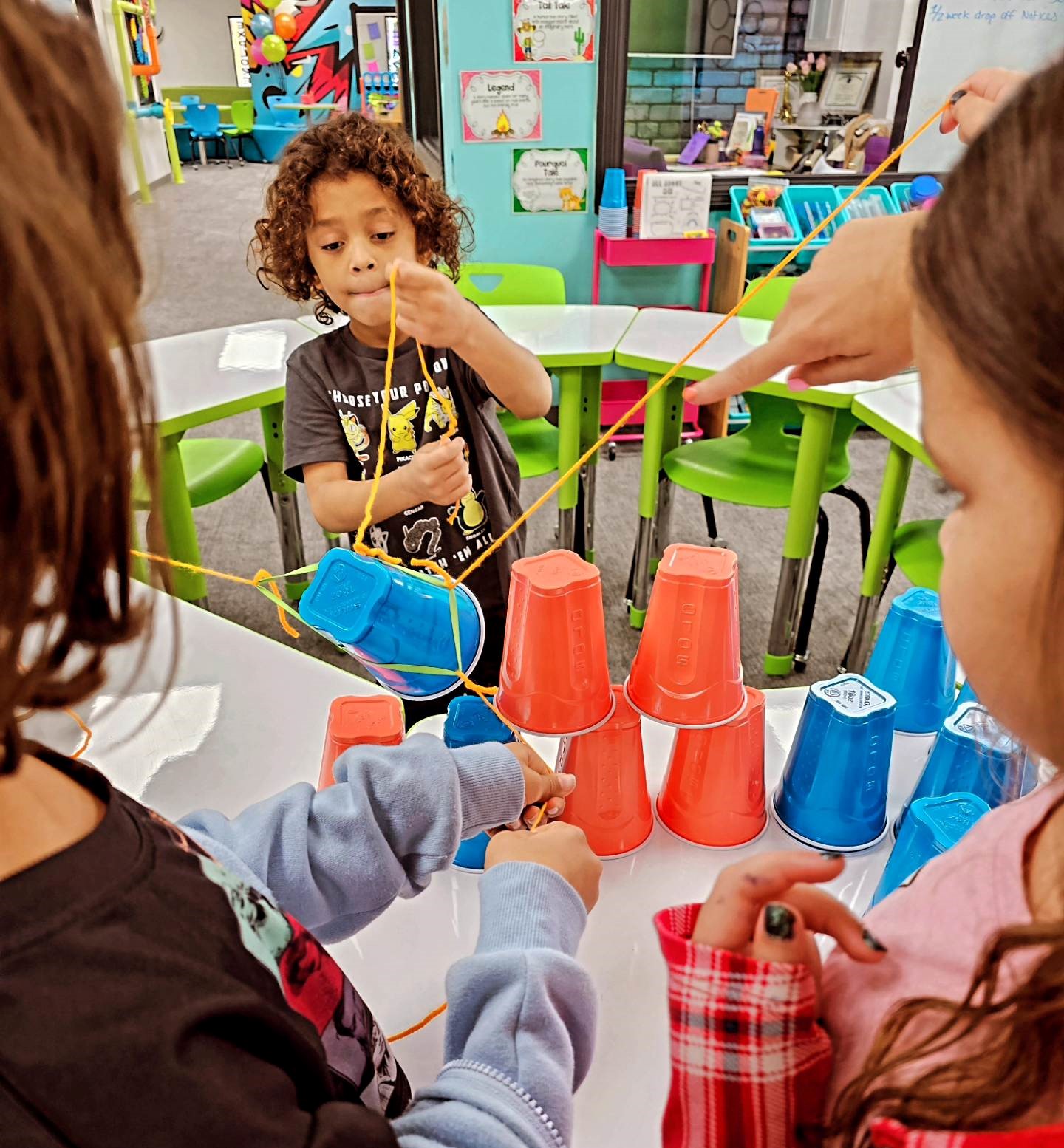 Her heart sank.
Her heart sank.
Thankfully, it floated right back up, because in the next few minutes, 30 families appeared. “And every person who walked in the building said, ‘Oh my God, we need this! ‘ ”
The calls keep coming. Bedgood signed up 10 students on one day in August alone. Most of them use state-supported education savings accounts.
Bedgood said the response has been gratifying – and going her own way as a teacher, liberating.
“I needed to be able to break free. I felt like I was being caged,” Bedgood said, referring to traditional schools. “I knew I could do so much, but I was being limited.”
In Florida, a national leader in expanding education choice, it’s tough to keep up with the growing ranks of former public school teachers who are leveraging choice programs to create their own options.
Bedgood said she came to realize she could help more students by creating her own model – in this case, a K-8 tutoring center focused on math, reading, and enrichment that caters to a wide range of students with a wide range of schedules.
She didn’t come to this conclusion lightly.
Bedgood was the instructional coach at a high-poverty, public elementary school for six years. She found the work “exhilarating.” But she also began to have doubts about the best path forward.
Bedgood said she was effective in part because she had a principal who gave her the freedom to veer from district dictates; to “go rogue” when she thought she needed to. Bedgood said she re-ordered and re-focused some parts of the curriculum, doubled down on others, and better aligned it to state standards. She leaned into response boards for formative assessments. She made widespread use of manipulatives that previously were gathering dust.
Her approach worked. The school’s state-issued grade gradually rose from a D to an A. Math proficiency rose from 47 percent to 72 percent.
But Bedgood said she also saw that principals like hers were rare. And that not everybody had high expectations for high-poverty students.
“I knew it. I watched it. I saw kids who were Level 1’s (the lowest level on Florida’s standardized tests) shoot up to proficiency,” she said. And yet, in some places, “the climate was almost like, ‘These kids can’t do it.’ “
Bedgood asked herself: If I rose through the ranks, would I truly be in position to do what works?
Ultimately, she concluded, there was a good chance she wouldn’t be. So, she looked for the exit. She overcame fears about starting her own operation; persuaded her husband, a firefighter; consulted with experts, including other teachers; and found a good location without too much hassle.
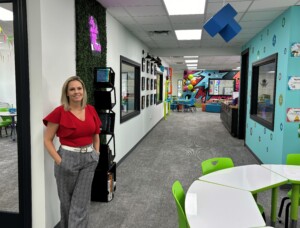 Bedgood describes Curious Innovators as a tutoring center and microschool. She opened in April with two students: Her own kids.
Bedgood describes Curious Innovators as a tutoring center and microschool. She opened in April with two students: Her own kids.
The center is 4,200 square feet, in a trim office building framed by oaks and palms. The interior is colorful and comfortable, with giant, geometric puzzle pieces hanging from the ceiling, all of it designed to stimulate creativity. There are separate rooms for reading, math, and STEM, and multiple stations for students to collaborate.
Bedgood employs five instructors, three of them full time. Two are former public school teachers.
All the students are homeschooled.
Some need tutoring in reading and/or math. Some are there for enrichment. Some mix and match from both. Bedgood emphasizes project-based and inquiry-based learning, but each student’s programming is created in tandem with them and their parents.
Reading and math classes are offered three days a week. Enrichment classes include art, music, drama, debate, creative writing, STEM, and entrepreneurship.
Maria Tobon signed up her daughter and son for math, reading, and science this fall after getting to know Curious Innovators during a three-week summer program. They attend full days on Mondays and Fridays.
One of her children uses Florida’s Family Empowerment Scholarship for Students with Unique Abilities. The other uses a Personalized Education Program scholarship. Both are administered by Step Up For Students.
“The beauty of a tutoring program like Cristina has built is you can hand pick what you need,” said Tobon, a former Montessori teacher who manages a homeschool co-op.
Tobon said between all her children, she has experienced a full gamut of educational options, from traditional public schools to magnet, charter, and private schools. She decided to homeschool after one of her children was diagnosed with cancer, and the COVID-19 pandemic made traditional schooling too risky.
Homeschooling, she said, turned out to be “absolutely mind-blowing.”
“When I took control … they grew in every sense,” Tobon said. “Going back to a full-time program sounds like jail.”
Kristen Collins wanted part-time schooling for her children, too. Her husband travels a lot for work, and homeschooling allows the family to occasionally join him, without missing a beat educationally.
Bryson, 6, and Aaliyah, 8, both use PEP scholarships. They attend Curious Innovators full days on Tuesdays, Wednesdays, and Thursdays.
“It’s just a great happy medium,” Collins said. And her kids “don’t want to leave. They’re having a blast.”
In some ways, Bedgood’s approach to teaching and learning is mainstream.
She follows the “science of reading” for younger students and struggling readers. She uses standardized tests to gauge proficiency. She tends to follow the grade-level progressions laid out in state standards.
The difference is, she has the flexibility to deviate from those tools, or supplement them, in any way she and the parents see fit.
Collins said that approach is working for Aaliyah, who has struggled a bit in math.
“Cristina recognizes that students learn differently, with different modalities. It’s not one size fits all,” she said. Aaliyah “has only been there two and a half weeks, but I can see she’s getting to these higher levels.”
After experiencing what’s possible outside traditional schools, Bedgood said she couldn’t go back.
Giving parents and teachers options, she said, is the best path to progress.
“I want choice to be the primary form of education,” she said. “The change needs to come from out of the system.”
Something about the Periodic Table of Elements grabs Conrad Black’s interest. All those chemicals and their atomic numbers. He heard about it, read about it, but didn’t know anything about it.
Until this past school year.
For his fifth-grade science course, Conrad chose to learn about energy and chemistry, specifically, the Periodic Table.
“He is, in my opinion, the epitome of student-led learning,” said his mom, Melanie.
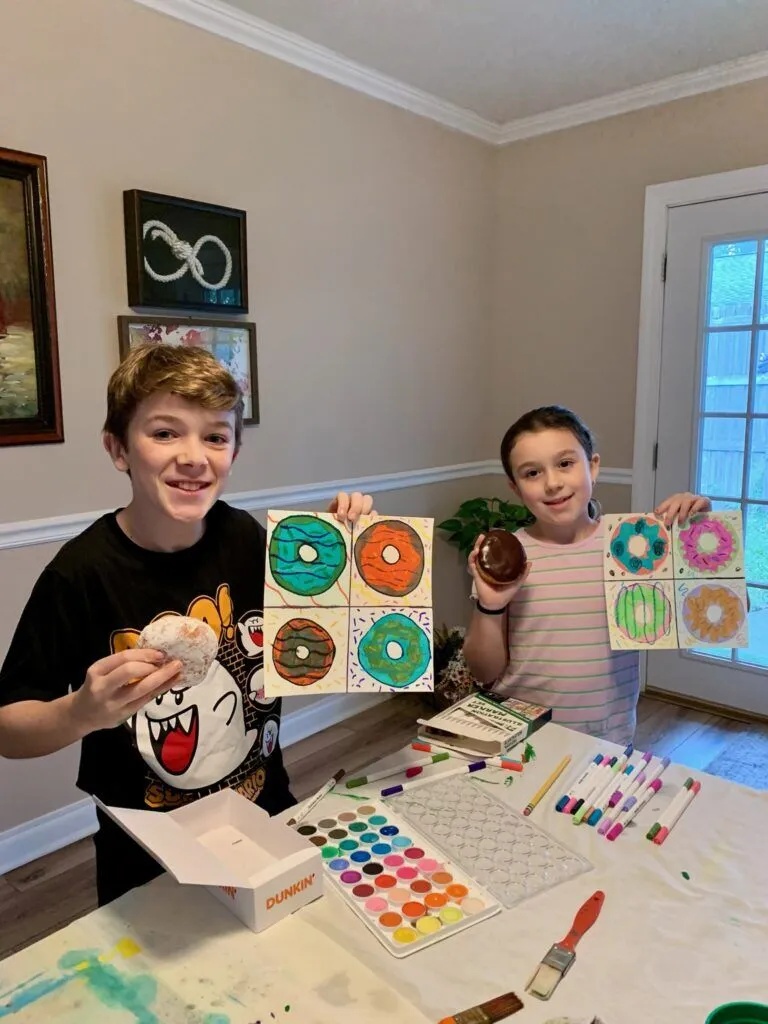
Conrad and Genevieve display their work during a lesson on Andy Warhol and pop art.
Melanie, a former middle school teacher, now teaches homeschool to her children, Conrad, 11, and Genevieve, 8.
With the help of the Personalized Education Program (PEP) that comes with the Florida Tax Credit Scholarship (managed by Step Up For Students), Melanie and her husband, Wesley, can tailor the curriculum to fit the needs of her children, letting their interests guide the curriculum.
“One of the things that we are so grateful for with regard to homeschooling is the flexibility and freedom,” Melanie said. “Conrad really appreciates that.”
The Blacks, who live in Jacksonville, have homeschooled their children for the past two years. The 2023-24 year was their first with the PEP, which was part of House Bill 1 that was signed into law in 2023. HB1 allows for an Education Savings Account (ESA) for students who are not enrolled full-time in a public or private school. It enables parents to customize their children’s education.
All PEP students are required to take a state-approved norm-referenced test annually. (The list of tests can be found here.) Conrad and Genevieve take the Iowa Assessment-Core Battery, which includes tests for science, math, social studies, and language arts.
Conrad loves coding, and through the program Scratch he has made stop-action videos and created a video game. His physical education class is karate, where he is two belts shy of being a black belt. The PEP covers his piano lessons. He developed an interest in cooking this past year, so the PEP paid for two cooking classes.
Genevieve learned to sew during the 2023-24 school year, and the scholarship has covered supplies for that craft. She competes with a local swim club, which constitutes her physical education class.
Both kids are active readers. Melanie has assigned books purchased through PEP. Conrad is a few chapters shy of finishing “The Hobbit.”
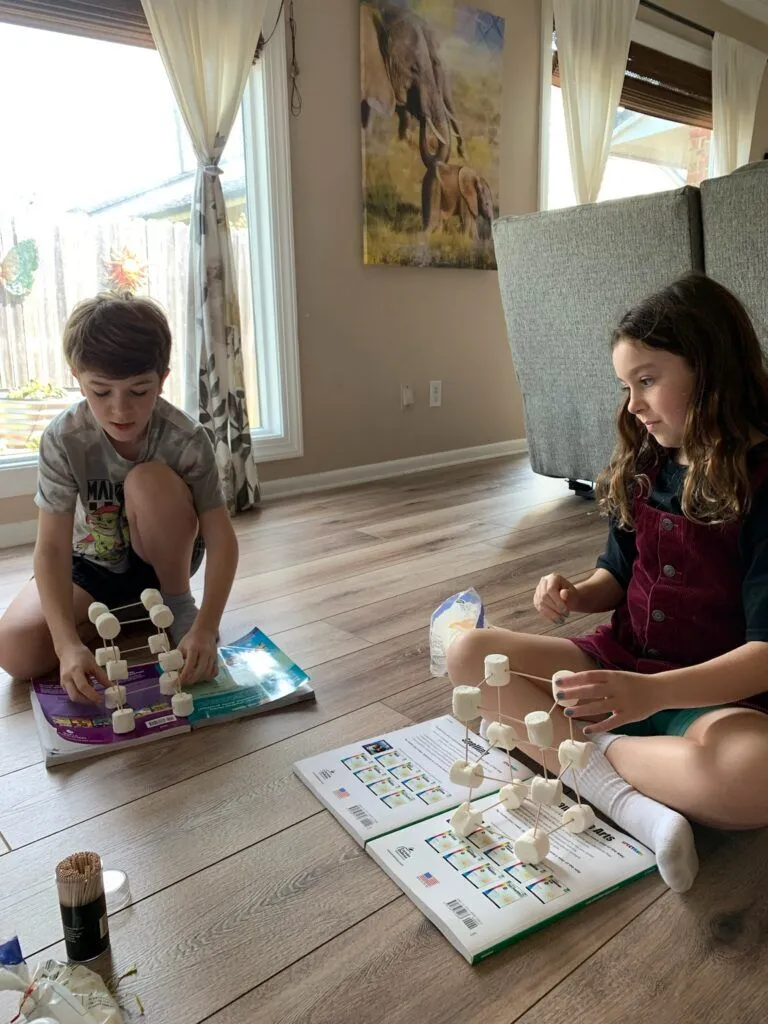
A science lesson on plate tectonics theory included sticks and marshmallows.
The PEP also covers field trips, and the Blacks have been on the go.
There were field trips to the children’s museum at Bonnet Springs Park in Lakeland, the Cade Museum for Creativity & Invention in Gainesville, and the Jacksonville Zoo and Gardens. During a family trip to the Florida Keys, they visited the The Turtle Hospital in Marathon.
“They always have ideas,” Melanie said. “I always ask them, ‘What's on your wish list for the school year? Where do you want to go? What kind of things do you want to learn about? What do you want to do?’ ”
Both Conrad and Genevieve said they enjoy being homeschooled.
“I can complete all my schoolwork and then just go on to the next one, instead of sitting around waiting for everybody else to complete whatever we're doing and waiting for the teachers to say what to do next,” Conrad said.
“One thing I noticed with homeschooling versus traditional schooling is the use of time,” Melanie said. “With homeschooling, I feel like we're able to get the most out of our time. Whereas what I noticed from when I worked as a teacher as well as when Conrad was in his neighborhood school, is that he would be waiting. He would finish his work and then he's waiting around.”
At home, when Conrad finishes one subject, he can move on to, say, the Periodic Table of Elements and satisfy that curiosity while learning the basics of chemistry.
“I've seen a bunch of stuff about it, and I knew nothing about it,” he said.
And?
“It’s pretty interesting,” he said.
For a creative project, Conrad and Genevieve both wrote books this year with a kit purchased with PEP funds.
Genevieve’s book was about two siblings who fought over ice cream.
“At the end, they got ice cream, but they probably weren't going to get ice cream if they didn't behave,” Genevive said.
So, who did they have to impress?
“Mom,” she said.
Conrad’s book is a little more involved.
Titled “Diary of an Insane Dream Warrior,” the plot includes a group of friends, a black hole, an alternate reality with floating islands, a massive, super-strong Minotaur, goat warriors, gun-slinging rabbits that resemble cowboys, an apple that can shapeshift, and government officials that cannot be trusted. He hasn’t finished it yet so he isn’t sure how it will end – other than the good guys win.
He does know that if it is made into a movie, the cast will include Chris Pratt, Chris Brown, Ryan Renolds, and Dwayne “The Rock” Johnson.
“The Rock would be great,” he said.
That is what Melanie means when she talks about the flexibility and creativity that comes with homeschooling with PEP. She can hone in on what interests her children and be innovative as they learn.
“[We use] the lessons that I create and anything they want to do. They have ideas, too, and we can say, ‘OK, let’s do it,’ ” she said. “It really offers us that ability to be so creative with learning, and so I think that's what we really appreciate most about homeschooling.”
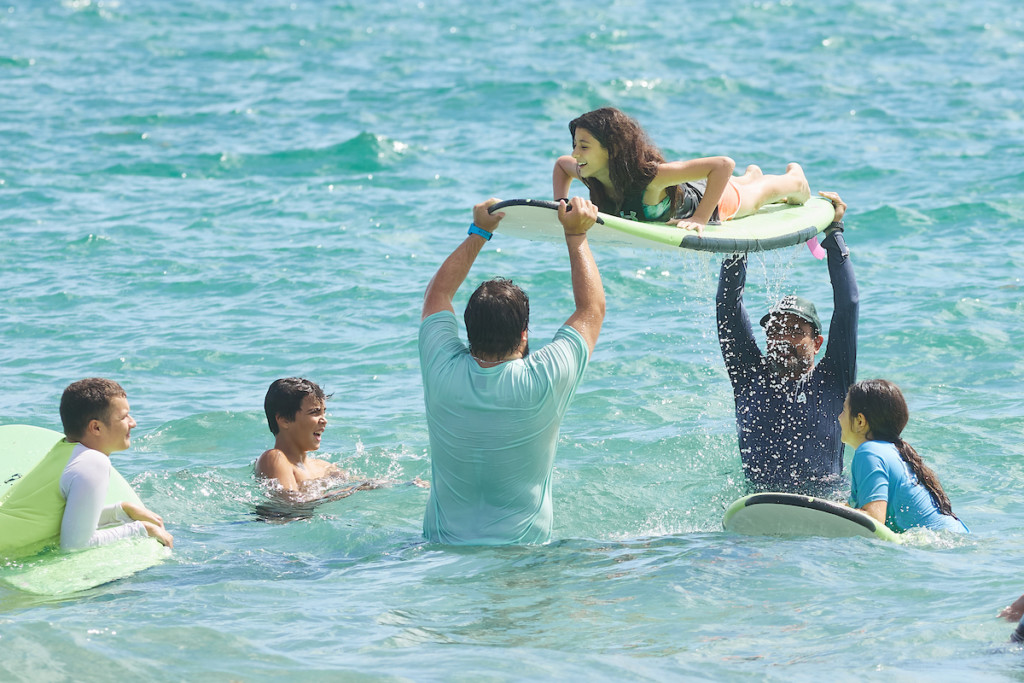
Organizations like Surf Skate Science pioneering new approaches to collaboration in public education. Photo credit: Chris Aluka Berry AlukaStorytellingPhotography.com
Despite calls for reform and waves of attempted transformation, key features of American schools have been remarkably stable for more than a century.
Students spend six or so hours a day, five days a week, sitting in rows of desks with other children about the same age, receiving instruction from their teachers in specific subjects: language arts, math, science and social studies. At the end of the year, they advance to the next grade. In high school, they socialize while standing next to banks of lockers, and the varsity football teams play on Friday nights.
These conventions persist despite their flaws. Students are frequently passed along to the next grade despite gaps in their academic foundations, leading them to graduate unprepared for life after school and few opportunities to close those gaps. If political leaders decide new knowledge or skills will be essential for students to thrive as adults — computer science, say, or financial literacy —cramming new subjects into the existing curriculum is a major headache.
The more time students spend in conventional schools, the more bored and disengaged they become. Some of the most engaging parts of schools have been relegated to the periphery—career academies, extracurriculars, sports, drama or music programs— where common schooling conventions hold the least sway. These are the places where students form deep relationships, develop lasting memories, and hone skills like creativity or teamwork.
So why do these conventions persist? Innovation researchers at the Clayton Christiansen Institute coined a term for one set of hidden forces that can keep an existing system in place despite pressure for change: A value network.
Textbook publishers and education technology companies design their products for conventional schools. Construction firms specialize in building them. Colleges train teachers to work in them. Complex webs of afterschool programs, summer camps, tutoring centers, and youth sports leagues all design their programs around conventional assumptions about when students will be in school. Parents and employers design the workweek around it.
These interdependent forces pose huge hurdles for any innovative educator who wants to break from convention. So, Christiansen's Thomas Arnett argues it’s best not to try within the confines of the existing system.
Instead, he advocates creating not just new learning experiences for children, but entirely new value networks that can allow new assumptions to take shape.
In Florida, and in in pockets all over the country, this is starting to happen. Here are two promising places to look for the value networks of the future.
Homeschool parents and community institutions
Some of the most valuable learning assets in most communities lie wholly or partially dormant during school hours. Museums. Parks. Zoos. Community centers. Science centers. Aquariums. Libraries. Performing arts theaters.
Their role in the value network of a conventional school system is relegated to the periphery: Hosting field trips, afterschool programs, or summer camps.
This is a huge missed opportunity. A single day a student spends at a place like this can often be the highlight of their school year. And while field trips are often rare and logistically complicated, there is evidence they not only help boost students’ academic learning, but help them develop character skills such as empathy and conscientiousness.
One group of students gets to experience these places more frequently, a way that is more central to their learning experience: Homeschoolers.
A growing number of community institutions, like libraries and science centers and museums, now offer dedicated programs for homeschool students.
If a trip to the aquarium could be the highlight of a student’s year, why not take them every month, or every week? Show them behind the scenes. Let them go deep learning about specific sea creatures or oceanic habitats and how they change over time. Offering learning opportunities of this sort would squarely align with an aquarium’s mission of increasing public understanding and appreciation of aquatic ecosystems.
Homeschool families are partnering with these community institutions (many of them public, by the way) to create new value networks that don’t relegate community assets to the periphery, and instead make them a central part of more children’s learning experiences. Over time, more children may benefit from these pioneering efforts.
Schools that partner by design
Right now, if an innovative educator creates a new way to teach chemistry through cooking, or math through music, or electrical engineering specifically for girls, they have three main options to find an audience for their idea: Start a whole new school, figure out how to sell their program to schools and districts, or create an option on the periphery—designing an afterschool program or summer camp and marketing it to families who pay out of pocket.
Each of these options is daunting. The existing education value network stifles the creativity of would-be entrepreneurs and keeps potential contributions of countless community members on the sidelines.
But here again, the efforts of a few pioneers have begun giving rise to new value networks, in this case by launching learning that are more inter-operable with other partners than conventional schools.
Like an old ship that creates a new home for coral, some of the earliest microschools and homeschool co-ops in South Florida have given rise to entire ecosystems of educators who create specific offerings and partner with smaller, more flexible learning environments to deliver them to students, as my colleague Ron Matus has documented.
The value network of the future
Other societal forces are creating pressure for new value networks in education. More parents than ever are working remote and flexible jobs. Scholarship programs allow more public education funding to follow students to whatever learning environment they choose. Information, which was scarce for most of human history, is now abundant.
If existing conventional schools find a way to adapt to these realities, it will likely be because they find ways to connect to entirely new value networks created by entrepreneurs working outside it.
Perun, the rock star of Australian defense economists doing awesome hour-plus hour PowerPoint presentations on YouTube, recently did two such presentations on “game-changing” weapon systems in the ongoing Ukraine-Russian war. Perun observed:
It seems like every time a new weapon system, be it Russian or Western, is sent to Ukraine, there are always going to be at least some voices in the media that amp this thing up as the next great game-changer, the system that will finally change the dynamics of this long and bloody war. For some systems the hype dies out, whereas for others it builds and builds until eventually the system arrives in Ukraine, and reality and expectations finally collide.
Some get to Ukraine and turn out to be utter disappointments. Others turn out to be solid, useful performers that do the job they were intended to do, but don’t exactly quickly or efficiently move the needle. And others swing in like a damn wrecking ball and on their first day of operations wreck two Russian airfields and deal the Russian aerospace forces their worst single day defeat since they were the Soviet Air Forces during the Second World War.
Inspired by the great Perun, we will here rank policy interventions designed to increase family options in K-12:
Magnet Schools: Introduced in the 1970s in the hopes of reducing racial segregation in public schools. Below is a placement of every magnet school in the nation with data included in the Stanford Educational Opportunity Project on Grades 3-8 academic growth:
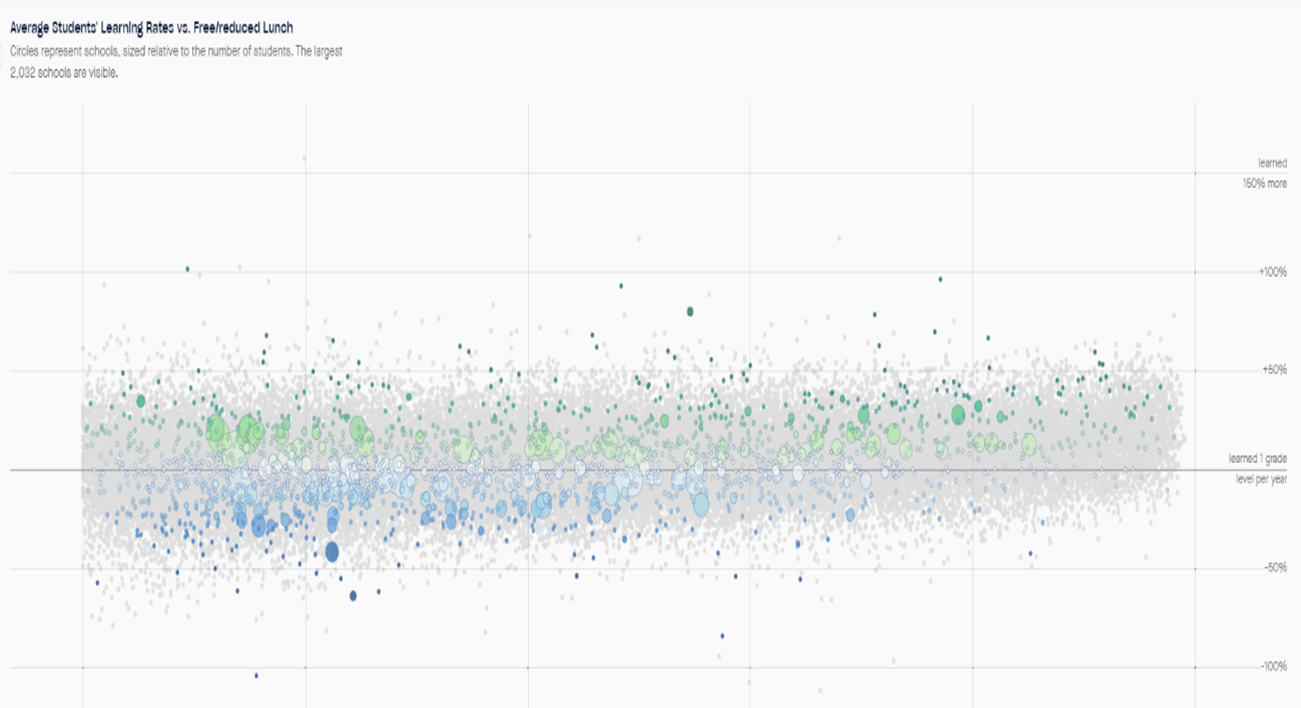
That’s a lot of schools, but their average rate of academic growth is approximately equal to the nation as a whole (half above and half below the “learned one grade level in one year” line. There are many fantastic magnet schools, but the system suffers from a fatal flaw: the schools are ultimately under the control of elected school boards. Many magnet schools have waitlists of students, but districts, for the most part, do not replicate or scale high-demand schools. Unless someone can demonstrate otherwise, let’s assume that Political Science 101 is controlling here and the people working in other district schools don’t want to scale high-demand magnet schools for the same reason they dislike other forms of choice: they view it as a threat. RANKING: TAME HOUSE PET
Charter Schools Introduced in the early 1990s by Minnesota lawmakers, charter schools eventually overtook magnet schools in numbers of schools, as you can see in the same chart as above for charters nationally:
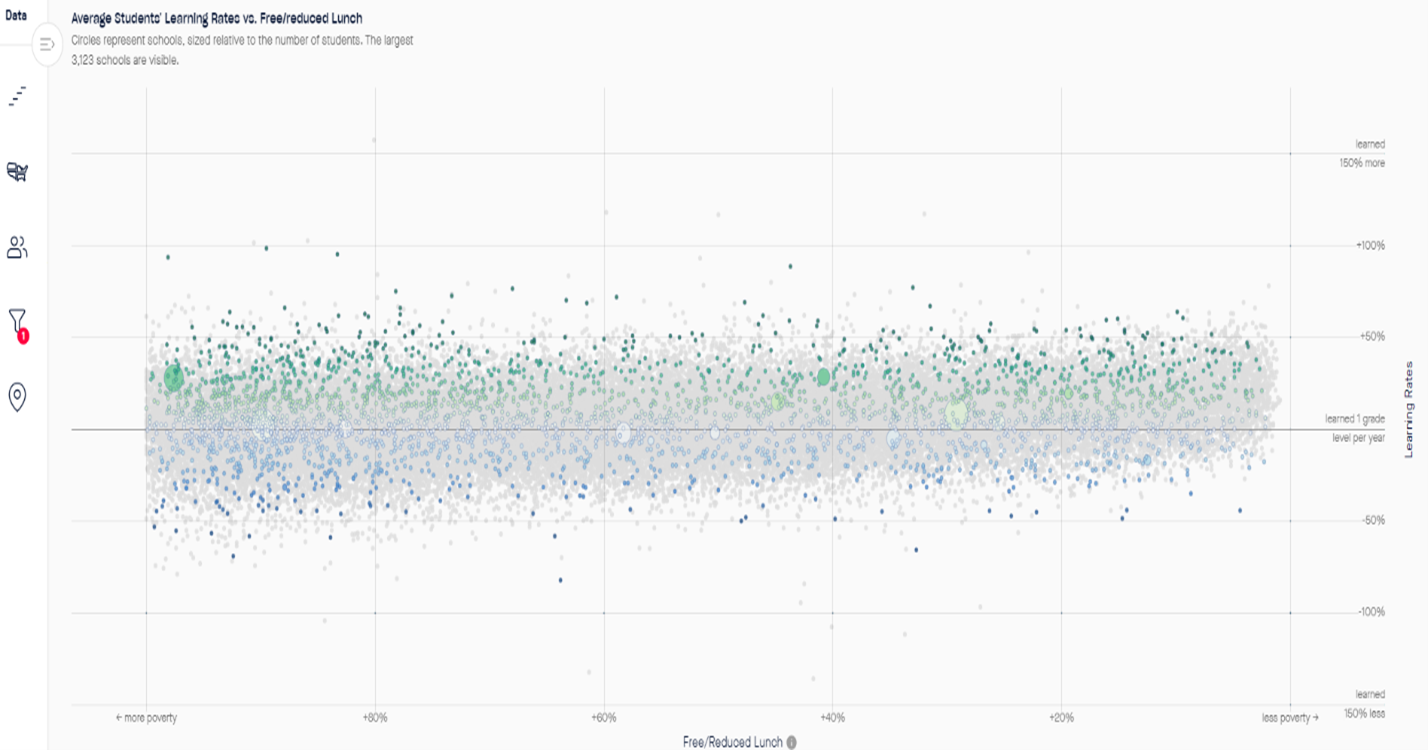
Charters were the leading form of choice for years after their debut, but more recently, it has become sadly clear that they suffer from a problem not terribly dissimilar from magnet schools: a political veto on their opening. Sometimes this veto is delivered by the same districts that fail to replicate high-demand magnet schools, in other instances, it happens because of Baptist and Bootlegger coalitions controlling state charter boards. What the Baptist and Bootleggers started, higher interest rates, building supply chain issues and the death of bipartisan education reform seems to have finished. RANKING: Varies by state but mostly TAME HOUSE PET
District Open Enrollment: Potentially an immensely powerful form of choice, but one which only realizes that potential if other forms of choice create the necessary incentives to get districts to participate. In most places, it looks far too much like this:
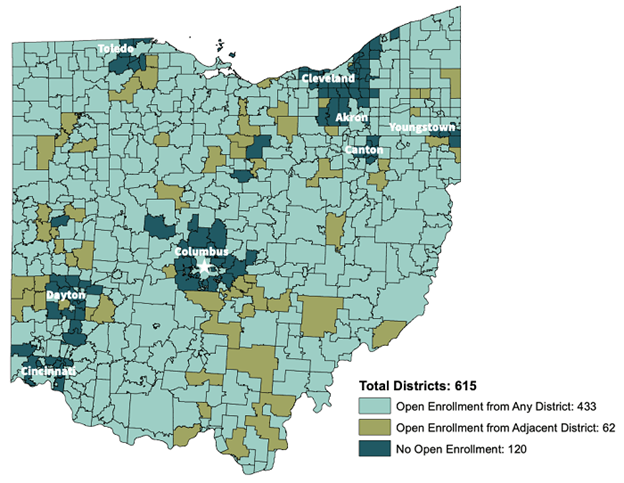
See any fancy suburbs willing to take urban kids in this map? Me neither. RANKING: Varies by state but mostly TAME HOUSE PET, could grow to become much, much more
School Vouchers/Scholarship Tax Credit: The modern private choice movement debuted in Wisconsin in 1990, the year before the first charter school law passed in 1991. Voucher adoption proceeded more slowly than charter school laws, and one of the accomplishments of the voucher movement may indeed have been to make charter schools seem safe by comparison. Scholarship tax credits, first passed in Arizona in 1997, expanded around the country more quickly than vouchers. While lawmakers passed several voucher and scholarship tax credit programs, few of them were sufficiently robust to perform critical tasks such as spurring increased private school supply, which requires either formula funding or regular increases in tax credit funding.
Scholars performed a tremendous amount of research on voucher and tax credit programs, and those programs led directly to the creation of education savings accounts (discussed next). Overall, however, these programs did not in and of themselves move the needle, although at times, the deployment of strong private and charter school programs did move the needle. RANKING: Vital Intermediate Step
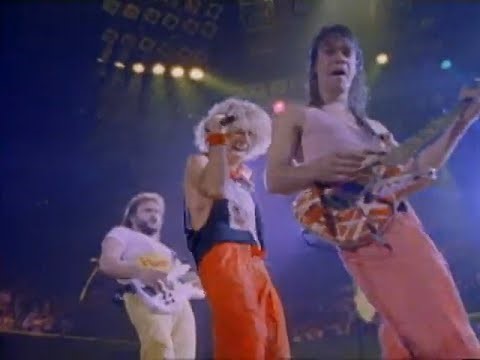
Education Savings Accounts: First passed by Arizona lawmakers in 2011 and going universal only in Arizona and West Virginia in 2022, ESA programs remain a work in progress. The flexibility of accounts contains the prospect of a less supply-constrained form of choice, less dependent upon the creation of one-stop shopping bundles known as “schools.” The largest first-year private choice programs have all been recently passed ESA programs, which seems promising. ESAs, however, have yet to become a teenager, and the technologies necessary to administer them at scale remain an evolving work in progress. RANKING: Promising but To Be Determined
Barely Off the DRAWING BOARD PLATFORM
Personal Use Refundable Tax Credits: Older but tiny programs exist that deliver small amounts of money and accomplish little. Oklahoma passed a more robust program of this type last year, but it remains far too early to draw any conclusions. RANKING: Totally TBD
Homeschooling:
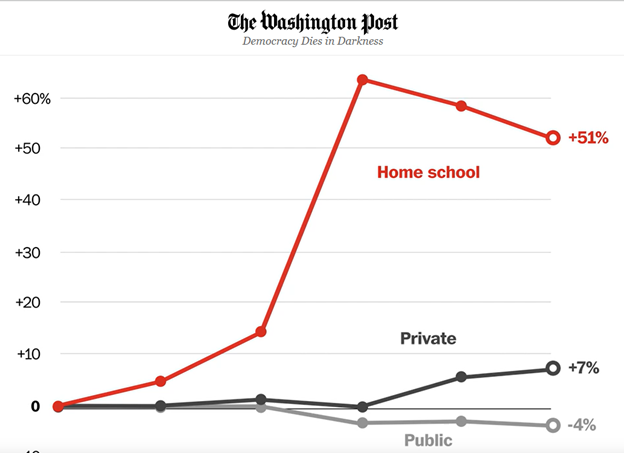
The homeschool movement has grown quickly is sufficiently organized to make lawmakers think long and hard before starting a quarrel with its supporters and has become more accessible with the advent of homeschool co-ops, which provides a measure of custodial care. RANKING: Wrecked two Russian airfields on the first day of deployment, unclear how high the ceiling will reach.
Conclusion: You should be seeking a combined arms operation in your state rather than a panacea-like super-weapon system that will deliver instant victory. You will know you are winning when your fancy, suburban districts start taking open-enrollment students. You will never achieve this with means-tested or geographically restricted private or charter school programs.